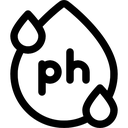Water Basics
North American households that live in hard water areas
%
Water heater energy costs saved with a water softener
%
Water available as drinking water for human consumption
%
Potential water contaminants not regulated by the EPA
%

HARD WATER
Hard water has a high mineral content. This will create scale on faucets, glass and water appliaces, like dishwaters and waters heaters, shortening their worklife

CHLORINE
Chlorine is a common disinfectant used by water utilities to remove bacterial contaminants. It can be unpleasant and potentially unsafe to consume and a skin irritant.

METALS
Iron, manganese, lead, copper, nikel, chromium and other metals occur in drinking water naturally and through polution. These can bioaccumulate, leadin to detraimental health impacts.

H₂S
Hydrogen Sulphide is a colorless gas with a strong odor of rotten eggs. When found in water it is typically the product of the bacterial breakdown of organic materials as well as human and animal waste.

LOW PH
Low PH drinking water is acidic and may have a harsh, metalic taste. it could also create bluish-green stains on fixtures.

NITRATES
Nitrate is a naturally occuring form of nitrogen, essential for plant growth. It is often used as a fertilizer, but can be hamful to human and animal health.

MICROBES
Various organic contaminants like algae, mold, bacteria, viruses and cysts can contaminate drinking water post treatment, and be unpleasant or harmful when consumed.

SYNTHETICS
Man made pharmaceutical and industrial compounds have been found in drinking water supplies and have proven challenging for conventional water treatment technologies.

